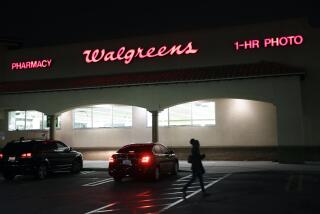Retail Slump Persists in September : Economy: The chains may be forced to mark down goods and keep inventories lean, which will could affect L.A.’s apparel industry.
America’s staggering chain stores took another pounding last month as most big retailers suffered dismal sales.
The results reported Thursday suggest that consumers can look forward to a blizzard of price markdowns, much like last year’s holiday shopping season.
Analysts also expect that the chains will cancel orders for some Christmas merchandise to keep their inventories lean, a move that could roil Southern California’s big apparel industry and other suppliers across the country.
More retail employment cuts could also be on the way, after this week’s announcements that Los Angeles-based Carter Hawley Hale Stores will slash 1,000 jobs and that New York’s Saks Fifth Avenue will eliminate 700.
September sales “for just about everyone were worse than they planned,” said Edward A. Weller, an analyst with Montgomery Securities in San Francisco.
More authoritative retail sales figures for September are due today from the federal government. In addition to the department store, general merchandise and specialty chains that released sales totals Thursday, the government figures include categories expected to show better results; namely, supermarkets and gasoline stations, whose revenues have skyrocketed since the onset of the Persian Gulf crisis.
Even so, analysts said the picture for retailing--as for the overall economy--is bleak.
“People don’t have money to spend,” said Sandra Shaber, an economist with the Futures Group in Washington. “You have a very weak job market; very, very small increases in earnings, and more inflation. That’s the worst possible combination of things for retail trade.”
Added Weller, “American consumers don’t want to buy anything anymore, and it’s going to get worse.”
Retailers’ figures for stores open more than one year--known as comparable-store or same-store results--were, save for a few exceptions, below the 3% to 4% inflation in the price of general merchandise over the past 12 months. In many cases, sales declined even before inflation.
Retailing analysts focus on comparable-stores figures to filter out the impact of special promotions at new stores and to scrutinize the performance of the ongoing business.
The best news came from Wal-Mart Stores, which posted a 9% rise in comparable-store sales and 24% overall, and from Gap Inc., which recorded an 8% comparable-store gain and 17% overall. Those increases, however, were lower than in past months.
The story was worse at other retailers. Even at the high-flying Limited Inc., sales at stores open at least one year fell 3%. The Columbus, Ohio-based chain, the nation’s No. 1 specialty apparel retailer, said it expects third-quarter profit margins to be “somewhat lower” than a year ago.
Carter Hawley Hale, parent of the Broadway-Southern California and four other chains, said its same-store volume was down 1.3%; overall sales declined 0.2%.
Among other reports:
* J. C. Penney Co.’s same-store sales fell 3.4%, and overall sales were off 2.3%.
* Woolworth Corp.’s same-store totals were up 2.1%. The retailer posted an overall 6.2% rise in sales.
* May Department Stores Co., parent of Robinson’s and May Co. California in Los Angeles, reported that same-store sales were down 1.8% but that overall results were up 3.5%.
More to Read
Inside the business of entertainment
The Wide Shot brings you news, analysis and insights on everything from streaming wars to production — and what it all means for the future.
You may occasionally receive promotional content from the Los Angeles Times.










